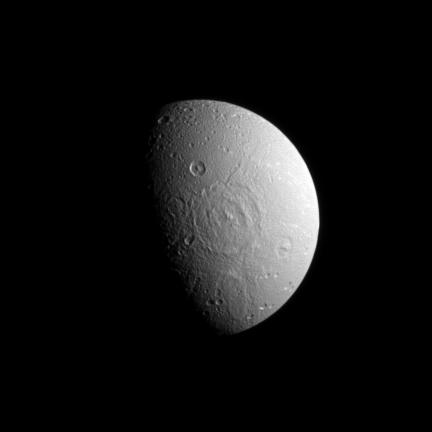Dione’s Pockmarked Side

| PIA Number | PIA11456 |
|---|---|
| Language |
|
A broad impact basin hints at Dione's split personality in this image from the Cassini spacecraft.
Dione's leading hemisphere is heavily cratered by impacts while its trailing hemisphere features bright ice cliffs created by tectonic fractures. This view looks toward the anti-Saturn side of Dione, a transition area between the two hemispheres where pockmarks give way to cracks.
North on Dione (1,123 kilometers, or 698 miles across) is up and rotated 26 degrees to the right. The image was taken in visible light with the Cassini spacecraft narrow-angle camera on Dec. 28, 2008. The view was acquired at a distance of approximately 785,000 kilometers (488,000 miles) from Dione and at a Sun-Dione-spacecraft, or phase, angle of 70 degrees. Image scale is 5 kilometers (3 miles) per pixel.
The Cassini-Huygens mission is a cooperative project of NASA, the European Space Agency and the Italian Space Agency. The Jet Propulsion Laboratory, a division of the California Institute of Technology in Pasadena, manages the mission for NASA's Science Mission Directorate, Washington, D.C. The Cassini orbiter and its two onboard cameras were designed, developed and assembled at JPL. The imaging operations center is based at the Space Science Institute in Boulder, Colo.
For more information about the Cassini-Huygens mission visit http://saturn.jpl.nasa.gov . The Cassini imaging team homepage is at http://ciclops.org .
Credit: NASA/JPL/Space Science Institute
